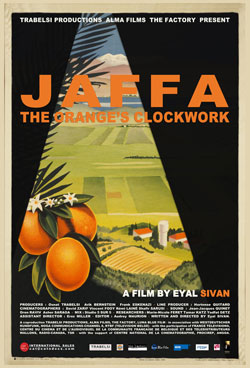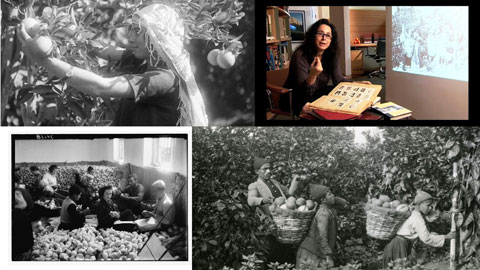Jaffa, the Orange’s Clockwork: Palestine, Israel—and the orange
By Lee Parsons
5 March 2011
Written and directed by Eyal Sivan
 Despite certain limitations, Jaffa, the Orange’s Clockwork, a feature-length documentary by Israeli-born filmmaker Eyal Sivan, has a good deal to recommend it, particularly in light of events now unfolding in the Middle East and North Africa.
Despite certain limitations, Jaffa, the Orange’s Clockwork, a feature-length documentary by Israeli-born filmmaker Eyal Sivan, has a good deal to recommend it, particularly in light of events now unfolding in the Middle East and North Africa.
The film, which has shown at numerous film festivals, including the 2010 Toronto Palestine Film Festival, is an engaging examination of the Arab-Israeli conflict traced through the role and history of the renowned Jaffa orange, illuminating unusual aspects of the region’s cultural history in an informative and decidedly personal fashion.
A wealth of materials, including archival photographs, film footage and other cultural artifacts, is interwoven with numerous interviews; they combine to offer a powerful refutation of the version of history promulgated by the Israeli elite and its apologists.
 From Jaffa, the Orange’s Clockwork
From Jaffa, the Orange’s ClockworkThe Jaffa orange, as the film notes, has been identified with the state of Israel largely due to a global publicity campaign long waged by that state. What is not widely known, and what we learn here, is how Israel effectively masked the appropriation of what was once the chief agricultural product of Arab peoples in the region as an integral part of a wider disinformation campaign.
Sivan, a veteran documentarian born in Haifa and who now lives in London, presumes a good deal of knowledge on the spectator’s part about the Middle East conflict, and so the audience is required to fill in many blanks. Moreover, the film’s underlying assumption is that the heart of the conflict lies in a struggle between Arab and Jewish nationalisms. A good deal is overlooked here, most notably the relations between the exploiters and the exploited, in both the Arab and Jewish communities. As well, little attention is paid to the machinations of the great powers in fomenting communal and national divisions to serve their own ends.
The film nevertheless brings to bear the experience and knowledge of a wide range of historians, artists, farmers and even Israeli officials—connected through the most important agricultural export of the region, the Jaffa orange, providing a rich background to its political history.
The family album
Proceeding more or less chronologically, Sivan questions a number of witnesses and scholars on the history of the citrus industry in the region. An old man looks at black-and-white photographs of the citrus harvest from his younger days. We see vintage film footage of workers in the orange groves, while an Israeli historian explains in a voiceover that “Here, Jews and Arabs work peacefully together”.
Watching archival footage, a Palestinian historian reflects on how the fame of “Jaffa the orange” has eclipsed any knowledge of “Jaffa the city”, which is now part of Tel Aviv, and attributes this in part to the sheer scale of the export that until recently saw nearly 5 million crates of the oranges exported annually.
He explains how in the latter days of Palestine, only 7 or 8 percent of the land was Jewish-owned, but nevertheless how “all worked together as a family. Whoever claims otherwise is ignorant of the situation of that period”. This is something of a theme throughout the film, but one senses that this picture of harmonious cooperation between workers and landowners, Arab or Jewish, should be taken with a certain grain of salt.
In one particularly hard-hitting segment, an elderly Palestinian worker explains with no apparent resentment how he came to be employed in the very orchards stolen from his family after 1948. He tells how their lands were seized by the government and run by the Custodian of Absentees’ Land who “took the harvests for themselves”, even as he toiled in his own orchards.
Historical falsification
A central slogan of Zionist propaganda was “a land without people for a people without land”. Rona Sela, an Israeli curator and researcher, demonstrates how early photographs of the region deliberately portrayed it as desolate, inviting conquest and cultivation.
Sela continues, showing how images of the orange were used to signify the liberation and taming of the land with the arrival of Jewish settlers. “First we appropriate their image, then we took their land after ’48—But that’s another story”.
Israeli historian Amnon Raz-Krakotzkin examines the claim that “the Jews were driven out” of historical Palestine, which he explains was originally a Christian myth, later adopted by the Zionists to prove their birthright and that their arrival was a return from exile. “The orange is attached to this theological myth in a way that serves to turn Palestine into the land of fulfillment of biblical culture”.
Jaffa, the Orange’s Clockwork shows that under the British mandate following the First World War, Arabs and Jews were integrated in the work of the citrus orchards. Shlomo Rizman of the Federation of Farmers in Israel notes, after the establishment of Israel and prior to the kibbutzim and the moshavim (varying forms of cooperative and collective farms), even those Jewish farmers who continued to hire Arab workers were persecuted by the state as “right wing” by the supposedly “socialist” Israeli government.
Palestinian historian and author Elias Sanbar notes that documentaries intended to justify Israeli ownership of the land portrayed the charming and antiquated lifestyle of the Arab workers alongside what appear as the much less attractive, almost militaristic, introduction of European agricultural technique by way of the immigration of European Jews. Further on, such images are related to the propaganda methods of the Stalinist regime used to promote Soviet agriculture.
Strike and expulsion
Although not treated in any detail, unfortunately, the role the colonial powers played in the region inevitably comes up for discussion. The British imperialists are condemned by both Jews and Arabs.
The film asserts that a turning point in the promotion of Jewish settlement to Palestine came in 1936 when dockworkers in the port city of Jaffa walked out for six months. The British, determined to maintain citrus exports, issued a permit to build a port across the bay at Tel Aviv, provoking outrage from the mostly Arab strikers. As one Arab worker relates, “It wasn’t the Jews, it was the English. It wasn’t the Arabs. It was the English—and so friction grew between them”.
The founding of Israel in 1948 witnessed the mass expulsion of the Arab population and the virtual destruction of Jaffa. We see footage of Arabs fleeing in boats, accompanied by an interview with former Israeli commander Yosef Nachmias. He makes no apology for the brutal actions of the Zionist regime and proudly relates how a census demonstrated that of the 85,000 Arabs once living in Jaffa, only 3,000 remained.
An aging Palestinian, Ismail Abou Shahadeh, provides an especially moving recollection. Earlier in the film, he reflects poetically on his days working in Jaffa. “You had to be in a plane to see the city. It was in the orchards. Orchards, orchards, houses and orchards everywhere”.
Now asked about the expulsion in 1948, he struggles to contain his emotions, “I’ve spoken about this more than once—it makes me cry. Suffice it to say that 4,000 bombs were dropped on Jaffa—and it was a small place”. And after a pause, “You must wipe 1948 from your mind. Forgetting is a blessing from God”.
Branding Israel
Discussing the use of the Jaffa orange in advertising campaigns, Zvi Kenan, former chairman of the Citrus Marketing Board of Israel admits, “We knew we were promoting Israel’s cause to the public…. In ’76 we learned it was second only to Coca-Cola in public awareness”.
Israeli historian Amnon Raz-Krakotzkin explains, “The Jaffa brand erased Jaffa. Zionist Israel took it and turned it into its own emblem, which wholly silences the Palestinians…. Israel of the oranges is Israel without Arabs. The ‘leftist’ Tel Aviv is the only Western city without Arabs. This is exactly the premise behind its secularism, to take the oranges and expel the Arabs”.
In one of the film’s final comments, Raz-Krakotzkin asserts that “The orange ought to be the symbol of both potentiality and destruction. Through the orange, you unfold the story of the Zionist seizure of the country in every way”.
Jaffa, the Orange’s Clockwork has deservedly received a number of international awards. Sivan’s other documentaries include The Specialist (1999), consisting entirely of footage of the 1961 trial of Adolf Eichmann, the Nazi official charged with the mass deportation of Jews to the death camps.
The director has come under attack for his views, including his declaration that the partition of Palestine and creation of Israel was an “historical error”. Sivan consistently points to the crying contradiction in the claim of the Israeli state to be correcting historic wrongs against the Jewish people while it continues to perpetrate injustice against the Palestinians.
One is not obliged to agree with all of Sivan’s views to offer sympathy and encouragement for the opposition to historical falsification and official Israeli policy expressed in Jaffa, the Orange’s Clockwork. The filmmaker’s efforts are an antidote to the uncritical support of Israeli oppression still routinely granted by Washington and its allies, along with the North American media.





Follow the WSWS